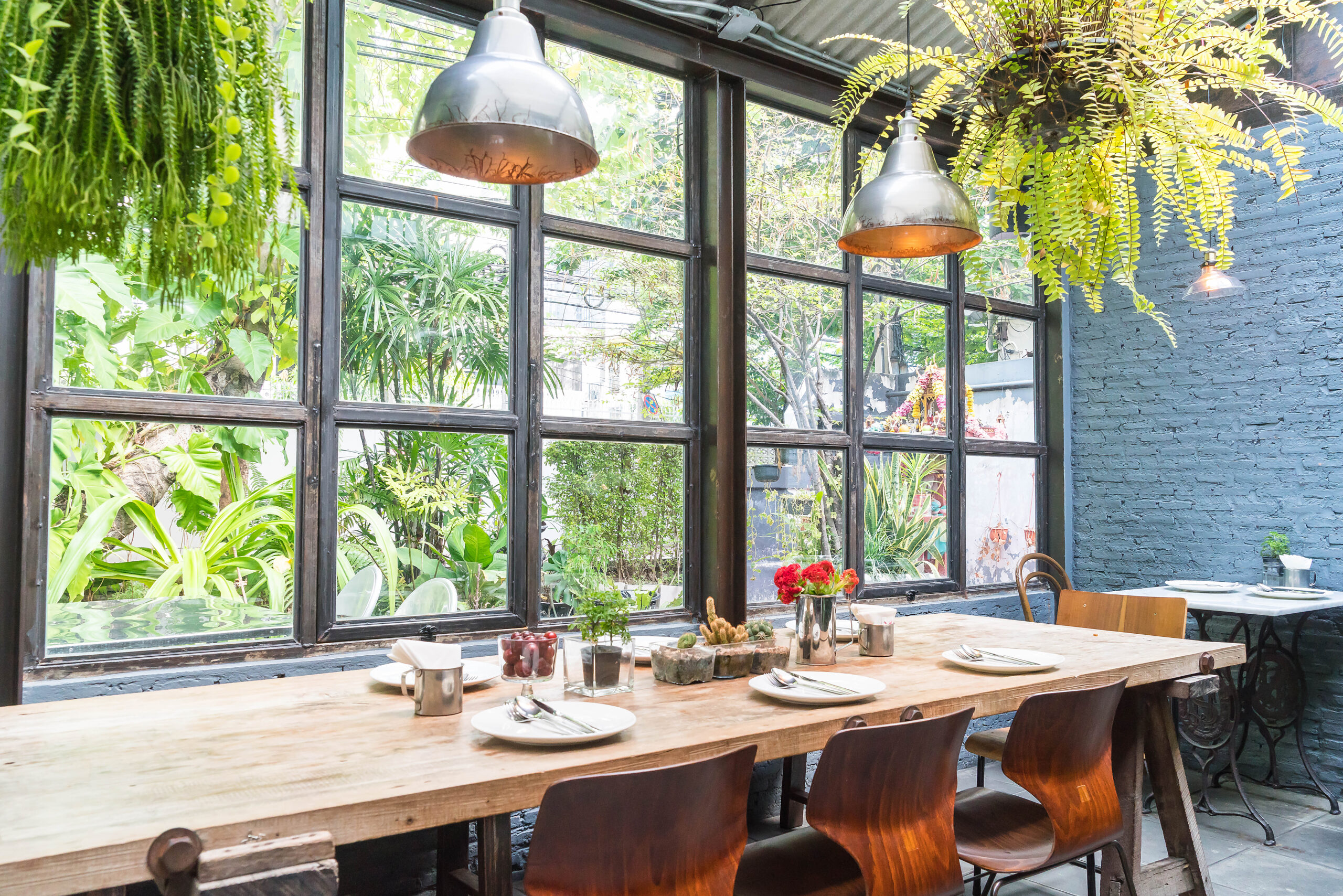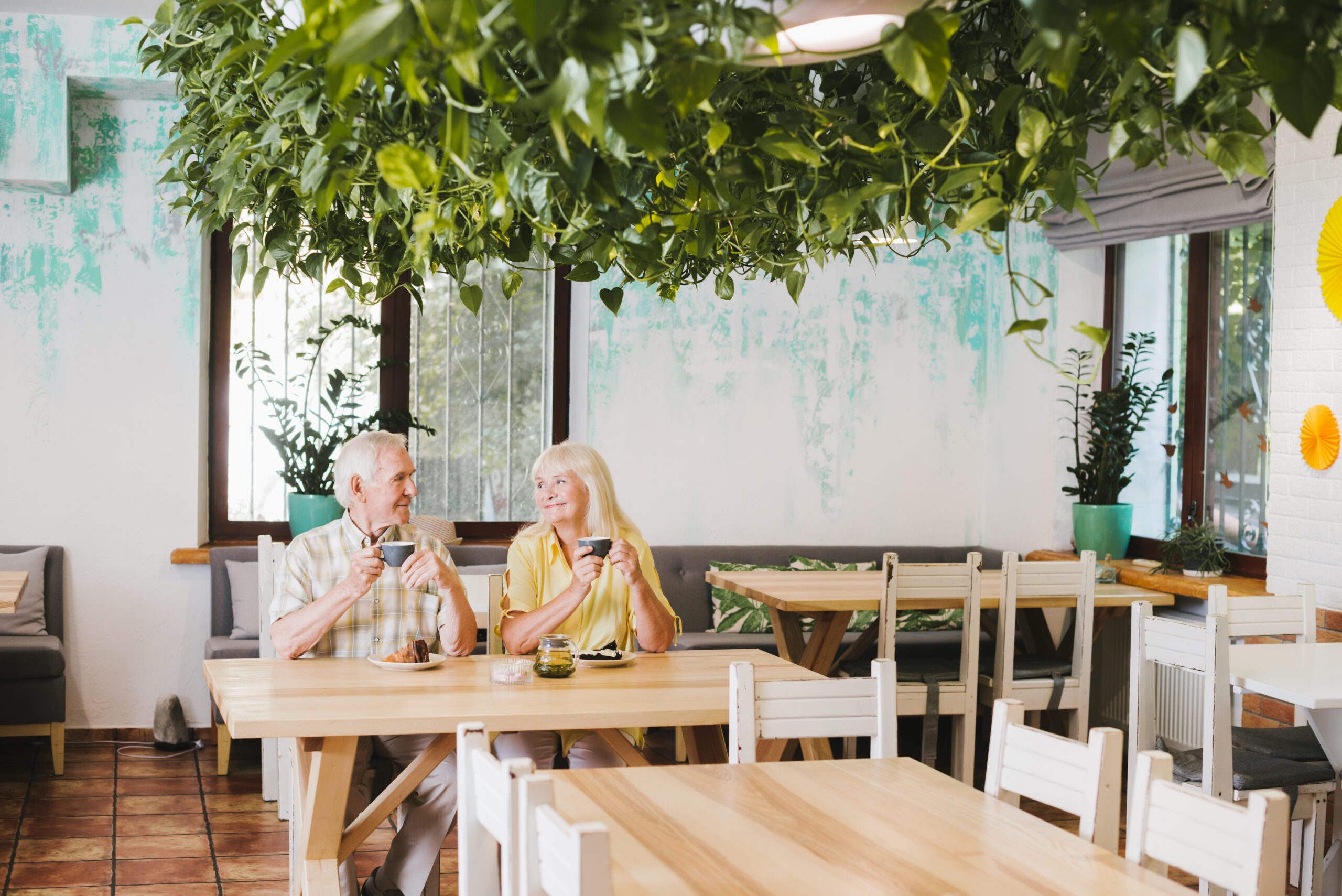Sustainable decor trends are not hard to incorporate into food based establishments. In saying so, here are some simple ways to include such concepts in your restaurant.
Indoor plants are also one of the top ideas for sustainable decor in restaurants, serving dual purposes. Adding greenery to dining space brings serenity and a welcoming touch, immediately connecting customers with nature and promoting sustainability. Be it small succulents on the table or an extensive vertical garden, plants clear the air by lessening carbon dioxide and filtering out harmful pollutants. They also enhance acoustics, dampening noise levels in busy dining areas by absorbing sound.
Low-maintenance plants, like snake plants or peace lilies which can thrive indoors with infrequent watering and care are usually the choice of sustainable restaurant owners. Vertical gardens, otherwise known as green walls, are an innovative way to maximise greenery in compact spaces. These living installations can double as striking design features while optimising wall space. Beyond aesthetics, plants indoors can align with eco-friendly practices by using biodegradable pots or incorporating a water-efficient irrigation system.
The restaurants can even grow their own herbs and micro greens for farm-to-table freshness, cutting down the transportation emissions and ensuring a very sustainable food supply chain. Moreover, integrating plants into the decor shows that the restaurant cares about environmental consciousness and will appeal to eco-minded diners. Merging functionality, aesthetic appeal and sustainability, indoor plants elevate the dining experience, contributing toward a greener planet.
This lowly yet profoundly impactful trend sets a complementary vibe inside the restaurant while strengthening the reinforcement of sustainable practices for which it was known within the hospitality industry.

DIY decor has become a cornerstone of sustainable design in restaurants, offering a unique blend of creativity, cost-effectiveness and eco-friendliness. By reusing materials and making their own decor, restaurants are able to cut down on waste while creating a personalised atmosphere that their customers will appreciate.
Common approaches to DIY include making old wine bottles into pendant lights, taking wooden pallets and turning them into shelving or wall art, and using reclaimed wood for custom furniture. Even items like mason jars, metal cans, or vintage utensils can be up-cycled into quirky light fixtures or planters. These projects not only cut down on manufacturing emissions but also give discarded materials a second life, aligning with the principles of a circular economy.
DIY decor often tells a story, adding a human touch to the dining experience. Guests appreciate originality and the effort behind handmade decor, which creates a connection between the restaurant’s ethos and its customers. In addition, community engagement is furthered by involving staff or local artisans in the creative process, reducing the need for mass-sourced items. This trend is particularly appealing to eco-conscious diners who value sustainability and authenticity in their dining choices.
All of these elements of DIY mean restaurants are able to refresh spaces more regularly without having to commit a huge budget or further harm the environment. For example, themes associated with a particular time of year can be creatively accomplished with existing materials. Through DIY decor, restaurants highlight their commitment to sustainability, while differentiating themselves in an increasingly green-conscious world as creative, eco-friendly spots.
One strong trend at restaurants these days involves making sustainable concepts and using recycled materials in such a way that your spaces are enriched with uniqueness, character-filled elements or special additions. Reclaimed woods may be refashioned as stunning tabletops, beautiful flooring or attractive wall panels that will exude some rustic charm while diminishing demands for newly harvested timber.
Similarly, recycled metals like aluminium or steel can be used to make light fixtures, bar counters or seating frames for an industrial-chic look. Glass bottles and jars can be transformed into pendant lights, vases or even works of art that hang on the wall to become conversation pieces for guests. Up-cycled furniture is another popular choice wherein old chairs, doors or benches are freshened up with minimal changes to add a vintage yet sustainable touch.
Recycling materials reduces landfill waste but also reduces the carbon footprint from manufacturing. Using locally sourced reclaimed materials reduces transportation emissions and helps to support community recycling efforts. Restaurants can even get creative and partner with local artists to create decor from unconventional items that have been recycled such as bicycle parts, shipping pallets or old books.
This approach not only aligns with the growing consumer preference for eco-conscious businesses but also allows restaurants to tell a compelling story through their interiors. A focus on recycled materials communicates values of resourcefulness, environmental responsibility and innovation, making the space both functional and meaningful. By integrating these elements, restaurants can create a visually striking yet planet-friendly ambiance that resonates with their diners.

Energy-efficient appliances play a dual role in modern restaurants, blending functionality with sustainable decor. These appliances are designed to minimise energy consumption and fit well with eco-friendly values, adding an aesthetic touch to open kitchens or visible spaces.
Energy-efficient refrigerators, ovens and dishwashers not only lower utility bills but also reduce the restaurant’s carbon footprint. Many of these appliances also feature sleek, modern designs complementary to contemporary restaurant interior style, fitting in effortlessly into minimalist or industrial themes. Take induction cooktops, which have smooth surfaces that enable more energy efficiency and a polished, professional-looking finish that can be exhibited even in open kitchen setups.
@chipotle Welcome to our new responsible restaurant, where we use renewable energy and everyone returns tabasco bottles to the drink station #chipotle #sustainability #restaurantdesign
Beyond functionality, incorporating energy efficiency into the aesthetic makeup accomplishes an important message on its own to customers about the sustainability mission of the restaurant. Energy-star certifications on the equipment or other visual evidence, will be present but subtle elements of décor in reinforcing this eco-consciousness into the business image.
Equally, a number of devices like smart refrigerators with glass doors enabled customer view into the chilled and fresh ingredients from their locally sourced providers add their kind of authenticity to such decorative touches.
To maximise the effect, restaurants can combine these appliances with other sustainable materials, such as reclaimed wood shelving or eco-friendly countertops, to create a cohesive green aesthetic. With the investment in energy-efficient appliances, restaurants can strike a perfect balance of style and practicality with environmental responsibility, making sustainability integral to their identity while creating an inviting space for customers.
Eco-conscious branding can be a strong way of aligning restaurants with sustainability values while improving the overall dining experience. Restaurants are able to communicate their commitment to the planet by incorporating environmentally friendly materials and thoughtful design into branding elements. Menus made from recycled paper or biodegradable materials, for example, reflect eco-consciousness while maintaining a stylish and rustic charm.
Tableware, like coasters and napkin holders, made out of bamboo, reclaimed wood or other sustainable materials contributes to subtle, constant messaging throughout the dining space. Even directional signage can get on board with sustainable trends through energy-efficient LED lighting, natural fibres or up-cycled materials that give them an artisan feel.
This eco-conscious restaurant decor can be a storytelling tool to tell where something came from or what the environmental outcome is. A restaurant can have wall installations or art by local artists made with recycled materials that are reflective of a local community — reducing the carbon footprint resulting from the decoration materials’ sources. Green branding extends even to packaging with takeout boxes and bags made out of compostable or recycled materials further reinforcing the sustainability ethos.
Incorporating eco-conscious branding into decor is more than a trend — it’s connecting with environmentally conscious diners who appreciate businesses making a difference. This approach not only reduces the environmental impact of the restaurant but also creates a cohesive, memorable experience that sets the restaurant apart in a competitive market.

Need help with interior design? I-dzine is your answer to it. We are experts in transforming space from virtual to reality. Our expertise in renovation design, oversight, and management ensures that your property is well-designed. We relentlessly focused on delivering meticulously created, beautiful, functional designs.